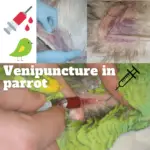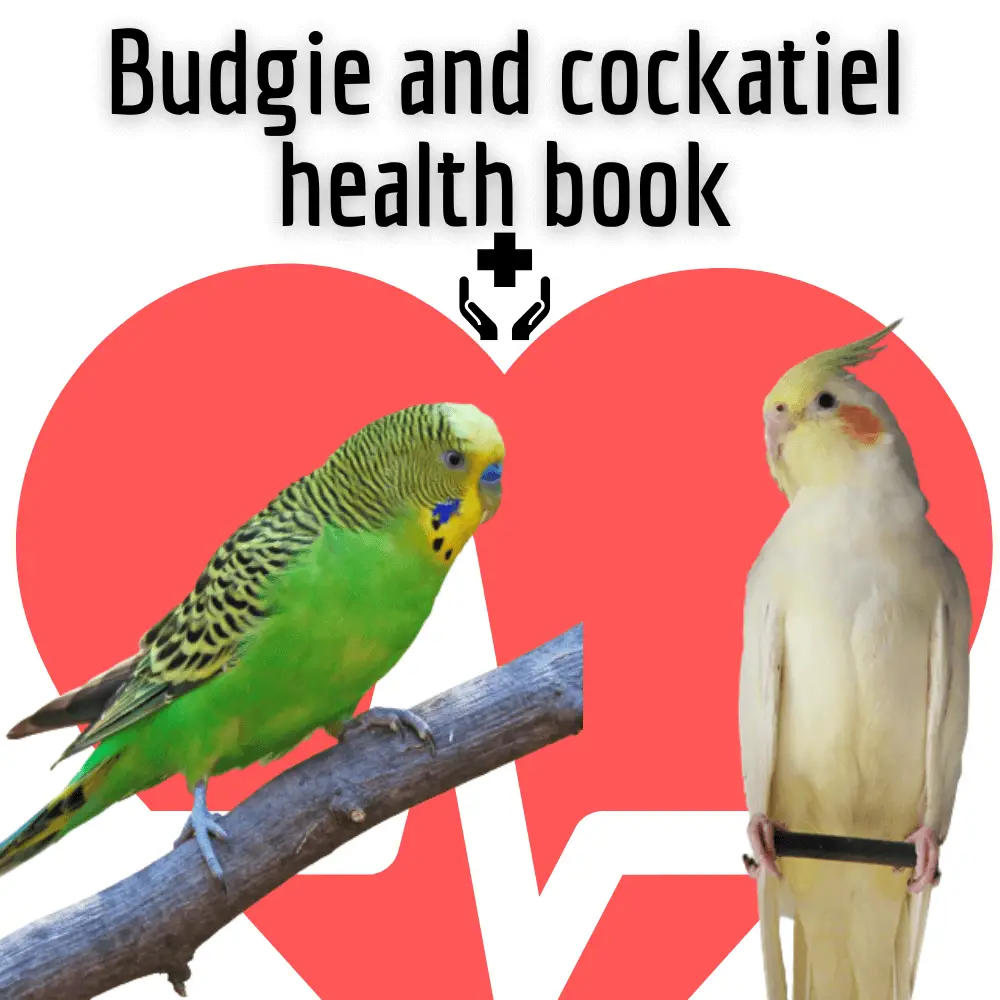
Budgie and cockatiel health book: The budgie ( Melopsittacus undulatus ) and the cockatiel ( Nymphicus hollandicus ) are two species that I meet very frequently in consultation. No wonder they are so popular: they each have an endearing personality and more and more bird lovers are literally falling under their spell!
Some health issues peculiar to these birds are discussed in this text along with some funny information about them.
Budgerigar
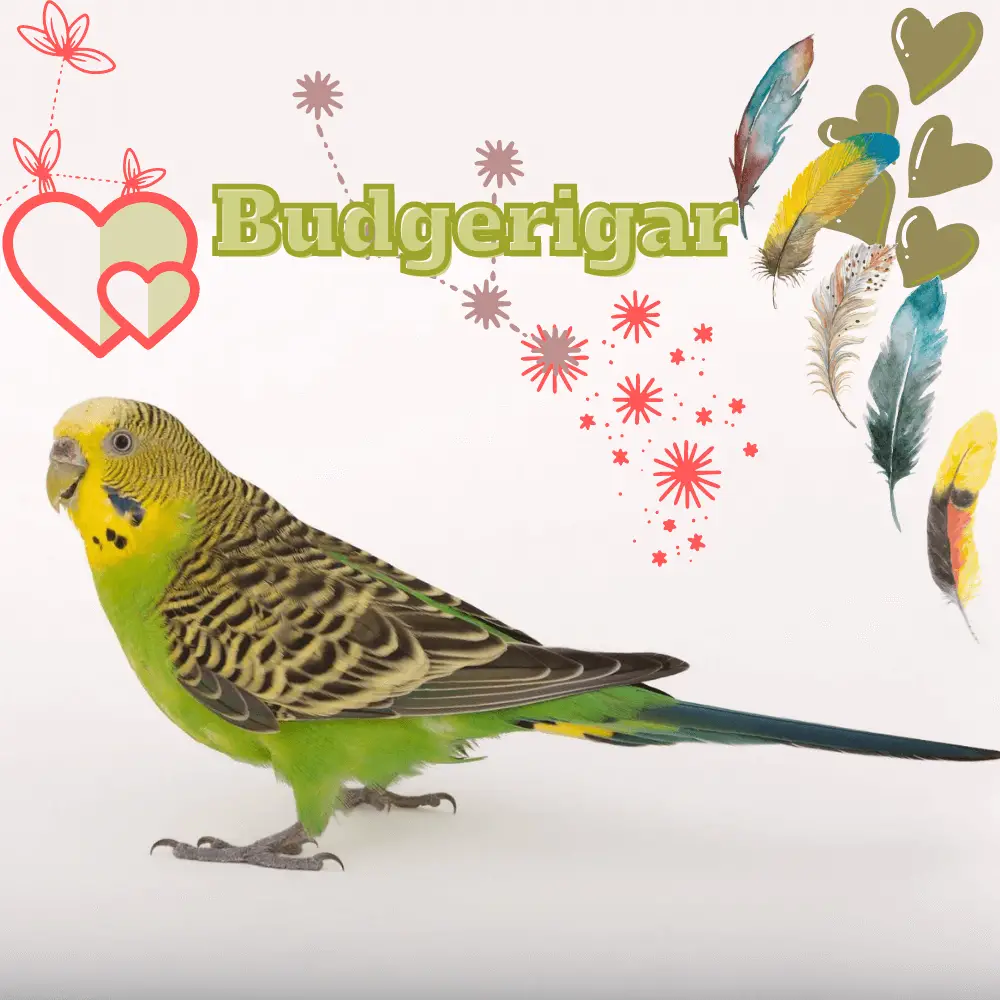
- It can be considered a domestic animal, as it has been bred in captivity since the 1800s.
- Sexual maturity occurs around the age of six (6) months in most individuals. However, the researchers observed that some early males were already producing sperm 60 days after leaving the nest.
- Normal longevity is between five (5) and ten (10) years, the record being eighteen (18) years.
- In its native Australian habitat, Budgerigars feed primarily on seeds from native plants.
- The parakeet is very active in nature and flies great distances. Several health problems encountered in captivity stem from their forced sedentary lifestyle ( trimmed flight feathers and cages that are too small ).
Cockatiel Parakeet
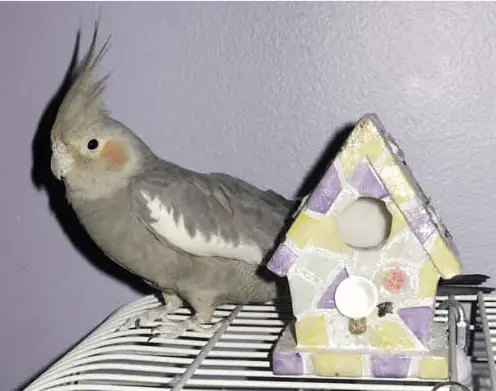
- Sexual maturity occurs between six (6) months and one (1) year.
- The maximum reported longevity for the cockatiel is thirty-two (32) years, although your small parrot will most likely live normal longevity of eighteen (18) to twenty-two (22) years.
- At six (6) months, the molt of baby feathers gives way to adult plumage.
- The cockatiel mainly consumes seeds in the wild.
Obesity
Obesity mainly affects the budgie, but also sometimes the cockatiel. An unbalanced diet and lack of exercise are the causes. The obese parrot is sometimes covered with large patches of fat called lipomas.
They form swellings, which look like swellings, in the abdomen and crop. A diseased liver is not uncommon in the obese bird. Indeed, the cells of the organ are easily invaded by fat which hinders their proper functioning.
As the liver participates in the proper clotting of the blood, it can be assumed that the bird with a weight problem will also have a delay in blood clotting. Concretely, a claw cut too short in this bird will bleed abnormally for a long time and will be difficult to cauterize.
Putting a bird on a diet should be done with great caution. Healthy foods are made available: mash, fresh vegetables, fruit, sprouted seeds, wheat or whole-grain bread, and pasta.
Regular seeds are never completely removed. It would be too risky for the parrot to stop feeding altogether. However, millet can be offered in larger quantities for die-hard seeds that refuse any other food. Millet contains less fat than other seeds.
Either way, any dietary change in the bird should be done gradually and under close supervision. You should never rush him. The anorexic bird is still in danger.
In addition to requiring more strain on the heart and causing premature wear and tear on the joints and the underside of the legs, excess weight predisposes to diabetes ( especially documented in female cockatiels ).
Do not hesitate to encourage your parakeet to exercise by providing him with a huge cage full of toys. Take him out often and involve him in your activities. When it comes to obesity, prevention remains the best solution. Losing weight on a parrot is never easy.
Feeding
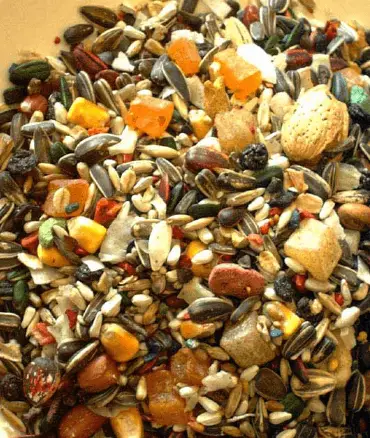
Dr. Margaret A. Wisseman made this observation at the Western Veterinary Conference in February 2003: she and some of her colleagues noticed that several cockatiels, fed exclusively on mussels, develop kidney disease over time.
The average age of these birds is between five (5) and ten (10) years. Dr. Wisseman hypothesizes that the feed may contain too much protein and/or vitamin D3 for this species of bird which mainly feeds on seeds in the wild. This excess damages the kidneys of the bird.
My personal experience tends to align with Dr. Wisseman’s observation. The autopsy of a few cockatiels fed only on feed, one of which also received a supplement of vitamins and minerals, indicated to me ( by microscopic analysis ) that the death was due to kidney disease secondary to overconsumption of vitamin D3.

The feed should not be eliminated from the cockatiel’s diet, but it is preferable that it is not the only food offered. Seeds, fruits, vegetables, and good table foods have their place in a balanced diet.
Poor functioning of the thyroid gland
Iodine deficiency causes swelling of the thyroid gland in the budgerigar. It then compresses the trachea and the esophagus and causes discomfort:
shortness of breath, wheezing when exercising or at rest, a tail that moves with each breath, regurgitation. The parakeet with a diseased thyroid often has a tendency to gain weight easily, and sometimes long, white fluff is visible through its colorful feathers.
This condition is rare these days. These parrots are mostly well-fed. Fortunately, the disease is cured well with an iodine supplement.
Parasites
Some are easy to observe and therefore diagnose. Others are much more hypocritical and their presence is betrayed only by very subtle symptoms.
Budgerigar’s beak gall – Knemidokoptes
Small microscopic moth, burrows in very small tunnels in the horn of the beak, the legs, and sometimes in the skin surrounding the eyes and the anus.
This particular activity of the parasite causes the affected parts of the bird to appear more or less thick white scabs. Contagion occurs through contact with an infected bird or a contaminated accessory.
Several species of birds can be infected, but the problem is found almost exclusively in the budgerigar. The parasite is easily controlled with Ivermectin.
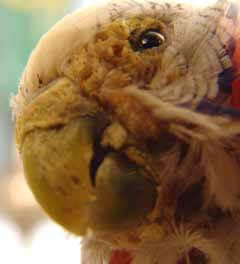
Red lice
This louse, active at night, sucks blood and spreads quickly from bird to bird. It also easily contaminates the environment. In the absence of a bird, this parasite dares to bite humans.
The problem is suspected in a bird that is intensely itchy and nervous, restless. To unmask the parasite: cover the cage with a white cotton ball and observe the presence of small mobile red dots at night. Ivermectin is an effective treatment.
Giardia sp
Several cockatiels and budgerigar are infested with this intestinal parasite without anything showing in the droppings. Its presence results in targeted pecking under the wings and on the legs, rarely elsewhere on the body. Treatment is sometimes difficult, as the parasite easily develops drug resistance.
Ascaris – roundworms
It seems that our birds from Quebec are rarely bothered by roundworms. However, with more and more frequent imports, it can be assumed that this problem will be encountered more and more, especially with birds originating from the United States.
Those from southern states, especially Florida, are almost always infested with this type of worm. Any bird from these areas should be dewormed routinely even if their stool test does not show the presence of parasite eggs.
It is possible to identify the original condition of an imported bird by observing the code written on its quarantine ring. Three letters and three numbers are inscribed on it. If the bird is from Florida.


